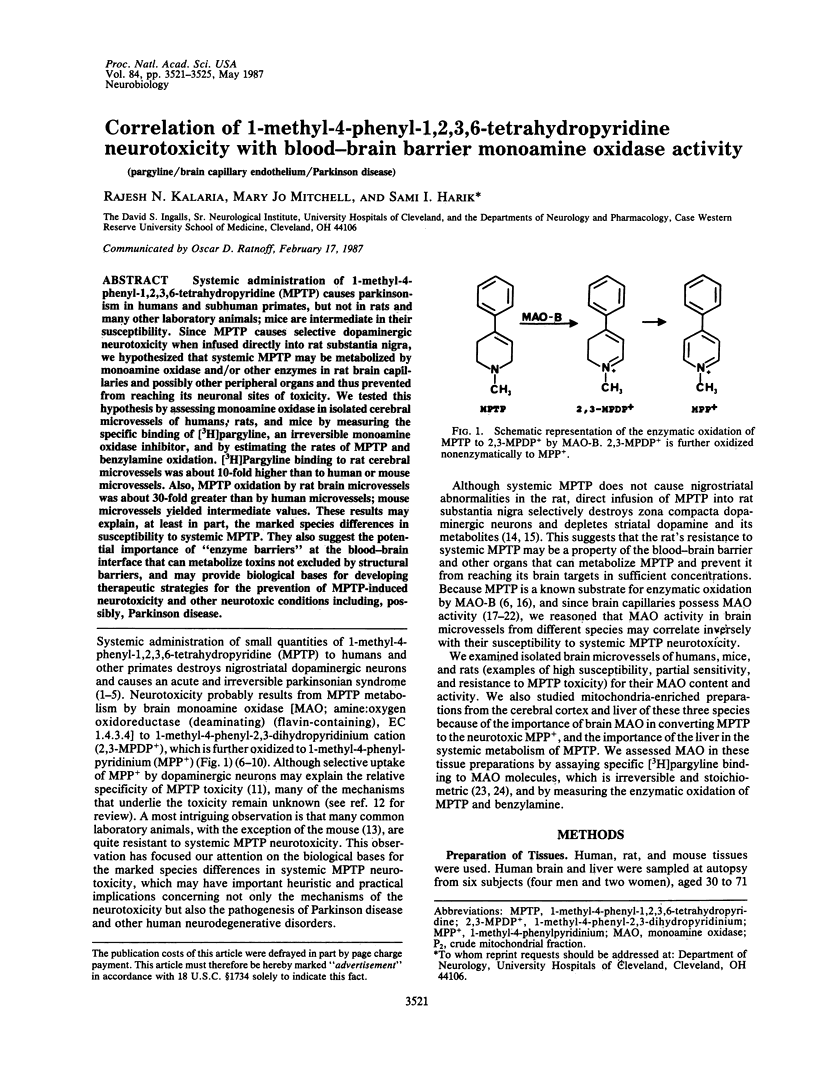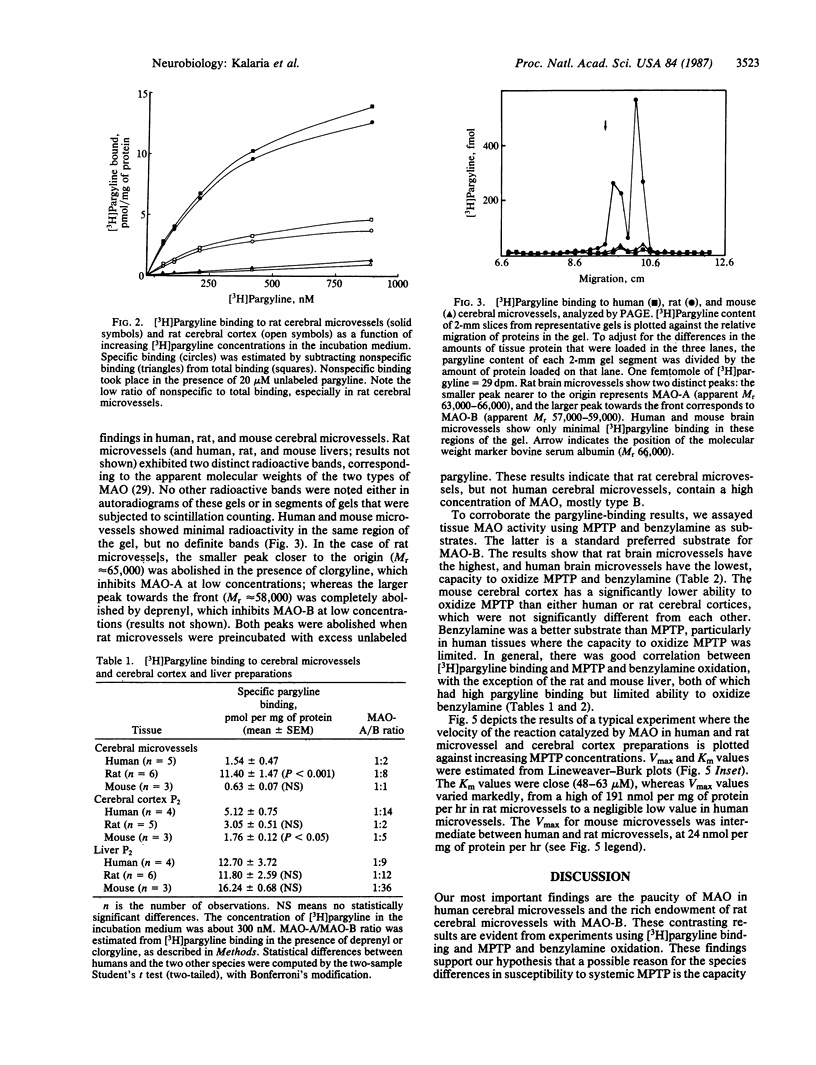Abstract
Systemic administration of 1-methyl-4-phenyl-1,2,3,6-tetrahydropyridine (MPTP) causes parkinsonism in humans and subhuman primates, but not in rats and many other laboratory animals; mice are intermediate in their susceptibility. Since MPTP causes selective dopaminergic neurotoxicity when infused directly into rat substantia nigra, we hypothesized that systemic MPTP may be metabolized by monoamine oxidase and/or other enzymes in rat brain capillaries and possibly other peripheral organs and thus prevented from reaching its neuronal sites of toxicity. We tested this hypothesis by assessing monoamine oxidase in isolated cerebral microvessels of humans, rats, and mice by measuring the specific binding of [3H]pargyline, an irreversible monoamine oxidase inhibitor, and by estimating the rates of MPTP and benzylamine oxidation. [3H]Pargyline binding to rat cerebral microvessels was about 10-fold higher than to human or mouse microvessels. Also, MPTP oxidation by rat brain microvessels was about 30-fold greater than by human microvessels; mouse microvessels yielded intermediate values. These results may explain, at least in part, the marked species differences in susceptibility to systemic MPTP. They also suggest the potential importance of "enzyme barriers" at the blood-brain interface that can metabolize toxins not excluded by structural barriers, and may provide biological bases for developing therapeutic strategies for the prevention of MPTP-induced neurotoxicity and other neurotoxic conditions including, possibly, Parkinson disease.
Full text
PDF




Images in this article
Selected References
These references are in PubMed. This may not be the complete list of references from this article.
- Burns R. S., Chiueh C. C., Markey S. P., Ebert M. H., Jacobowitz D. M., Kopin I. J. A primate model of parkinsonism: selective destruction of dopaminergic neurons in the pars compacta of the substantia nigra by N-methyl-4-phenyl-1,2,3,6-tetrahydropyridine. Proc Natl Acad Sci U S A. 1983 Jul;80(14):4546–4550. doi: 10.1073/pnas.80.14.4546. [DOI] [PMC free article] [PubMed] [Google Scholar]
- Cawthon R. M., Pintar J. E., Haseltine F. P., Breakefield X. O. Differences in the structure of A and B forms of human monoamine oxidase. J Neurochem. 1981 Aug;37(2):363–372. doi: 10.1111/j.1471-4159.1981.tb00464.x. [DOI] [PubMed] [Google Scholar]
- Chiba K., Peterson L. A., Castagnoli K. P., Trevor A. J., Castagnoli N., Jr Studies on the molecular mechanism of bioactivation of the selective nigrostriatal toxin 1-methyl-4-phenyl-1,2,3,6-tetrahydropyridine. Drug Metab Dispos. 1985 May-Jun;13(3):342–347. [PubMed] [Google Scholar]
- Chiba K., Trevor A., Castagnoli N., Jr Metabolism of the neurotoxic tertiary amine, MPTP, by brain monoamine oxidase. Biochem Biophys Res Commun. 1984 Apr 30;120(2):574–578. doi: 10.1016/0006-291x(84)91293-2. [DOI] [PubMed] [Google Scholar]
- Davis G. C., Williams A. C., Markey S. P., Ebert M. H., Caine E. D., Reichert C. M., Kopin I. J. Chronic Parkinsonism secondary to intravenous injection of meperidine analogues. Psychiatry Res. 1979 Dec;1(3):249–254. doi: 10.1016/0165-1781(79)90006-4. [DOI] [PubMed] [Google Scholar]
- Dick A. P., Harik S. I., Klip A., Walker D. M. Identification and characterization of the glucose transporter of the blood-brain barrier by cytochalasin B binding and immunological reactivity. Proc Natl Acad Sci U S A. 1984 Nov;81(22):7233–7237. doi: 10.1073/pnas.81.22.7233. [DOI] [PMC free article] [PubMed] [Google Scholar]
- Edelstein S. B., Breakefield X. O. Monoamine oxidases A and B are differentially regulated by glucocorticoids and "aging" in human skin fibroblasts. Cell Mol Neurobiol. 1986 Jun;6(2):121–150. doi: 10.1007/BF00711066. [DOI] [PubMed] [Google Scholar]
- Feldman J. M., White-Owen C., Klatt C. Golden hamster pancreatic islets: a tissue rich in monoamine oxidase. Endocrinology. 1980 Nov;107(5):1504–1511. doi: 10.1210/endo-107-5-1504. [DOI] [PubMed] [Google Scholar]
- Hardebo J. E., Owman C. Barrier mechanisms for neurotransmitter monoamines and their precursors at the blood-brain interface. Ann Neurol. 1980 Jul;8(1):1–31. doi: 10.1002/ana.410080102. [DOI] [PubMed] [Google Scholar]
- Harik S. I., Doull G. H., Dick A. P. Specific ouabain binding to brain microvessels and choroid plexus. J Cereb Blood Flow Metab. 1985 Mar;5(1):156–160. doi: 10.1038/jcbfm.1985.20. [DOI] [PubMed] [Google Scholar]
- Harik S. I., Sharma V. K., Wetherbee J. R., Warren R. H., Banerjee S. P. Adrenergic and cholinergic receptors of cerebral microvessels. J Cereb Blood Flow Metab. 1981;1(3):329–338. doi: 10.1038/jcbfm.1981.36. [DOI] [PubMed] [Google Scholar]
- Heikkila R. E., Hess A., Duvoisin R. C. Dopaminergic neurotoxicity of 1-methyl-4-phenyl-1,2,5,6-tetrahydropyridine in mice. Science. 1984 Jun 29;224(4656):1451–1453. doi: 10.1126/science.6610213. [DOI] [PubMed] [Google Scholar]
- Heikkila R. E., Manzino L., Cabbat F. S., Duvoisin R. C. Protection against the dopaminergic neurotoxicity of 1-methyl-4-phenyl-1,2,5,6-tetrahydropyridine by monoamine oxidase inhibitors. Nature. 1984 Oct 4;311(5985):467–469. doi: 10.1038/311467a0. [DOI] [PubMed] [Google Scholar]
- Heikkila R. E., Manzino L., Cabbat F. S., Duvoisin R. C. Studies on the oxidation of the dopaminergic neurotoxin 1-methyl-4-phenyl-1,2,5,6-tetrahydropyridine by monoamine oxidase B. J Neurochem. 1985 Oct;45(4):1049–1054. doi: 10.1111/j.1471-4159.1985.tb05522.x. [DOI] [PubMed] [Google Scholar]
- Hellerman L., Erwin V. G. Mitochondrial monoamine oxidase. II. Action of various inhibitors for the bovine kidney enzyme. Catalytic mechanism. J Biol Chem. 1968 Oct 25;243(20):5234–5243. [PubMed] [Google Scholar]
- Javitch J. A., D'Amato R. J., Strittmatter S. M., Snyder S. H. Parkinsonism-inducing neurotoxin, N-methyl-4-phenyl-1,2,3,6 -tetrahydropyridine: uptake of the metabolite N-methyl-4-phenylpyridine by dopamine neurons explains selective toxicity. Proc Natl Acad Sci U S A. 1985 Apr;82(7):2173–2177. doi: 10.1073/pnas.82.7.2173. [DOI] [PMC free article] [PubMed] [Google Scholar]
- LOWRY O. H., ROSEBROUGH N. J., FARR A. L., RANDALL R. J. Protein measurement with the Folin phenol reagent. J Biol Chem. 1951 Nov;193(1):265–275. [PubMed] [Google Scholar]
- Lai F. M., Spector S. Studies on the monoamine oxidase and catechol-O-methyltransferase of the rat cerebral microvessels. Arch Int Pharmacodyn Ther. 1978 Jun;233(2):227–234. [PubMed] [Google Scholar]
- Lai F. M., Udenfriend S., Spector S. Presence of norepinephrine and related enzymes in isolated brain microvessels. Proc Natl Acad Sci U S A. 1975 Nov;72(11):4622–4625. doi: 10.1073/pnas.72.11.4622. [DOI] [PMC free article] [PubMed] [Google Scholar]
- Langston J. W., Ballard P. Parkinsonism induced by 1-methyl-4-phenyl-1,2,3,6-tetrahydropyridine (MPTP): implications for treatment and the pathogenesis of Parkinson's disease. Can J Neurol Sci. 1984 Feb;11(1 Suppl):160–165. doi: 10.1017/s0317167100046333. [DOI] [PubMed] [Google Scholar]
- Langston J. W., Forno L. S., Rebert C. S., Irwin I. Selective nigral toxicity after systemic administration of 1-methyl-4-phenyl-1,2,5,6-tetrahydropyrine (MPTP) in the squirrel monkey. Brain Res. 1984 Feb 6;292(2):390–394. doi: 10.1016/0006-8993(84)90777-7. [DOI] [PubMed] [Google Scholar]
- Langston J. W., Irwin I., Langston E. B., Forno L. S. Pargyline prevents MPTP-induced parkinsonism in primates. Science. 1984 Sep 28;225(4669):1480–1482. doi: 10.1126/science.6332378. [DOI] [PubMed] [Google Scholar]
- Lasbennes F., Sercombe R., Seylaz J. Monoamine oxidase activity in brain microvessels determined using natural and artificial substrates: relevance to the blood-brain barrier. J Cereb Blood Flow Metab. 1983 Dec;3(4):521–528. doi: 10.1038/jcbfm.1983.80. [DOI] [PubMed] [Google Scholar]
- Lasbennes F., Sercombe R., Verrecchia C., Seylaz J. Vascular monoamine oxidase activity in the rat brain: variation with the substrate and the vascular segment. Life Sci. 1985 Jun 10;36(23):2263–2268. doi: 10.1016/0024-3205(85)90338-8. [DOI] [PubMed] [Google Scholar]
- Mackay A. V., Davies P., Dewar A. J., Yates C. M. Regional distribution of enzymes associated with neurotransmission by monoamines, acetylcholine and GABA in the human brain. J Neurochem. 1978 Apr;30(4):827–839. doi: 10.1111/j.1471-4159.1978.tb10791.x. [DOI] [PubMed] [Google Scholar]
- Markey S. P., Johannessen J. N., Chiueh C. C., Burns R. S., Herkenham M. A. Intraneuronal generation of a pyridinium metabolite may cause drug-induced parkinsonism. Nature. 1984 Oct 4;311(5985):464–467. doi: 10.1038/311464a0. [DOI] [PubMed] [Google Scholar]
- Rakic P. Limits of neurogenesis in primates. Science. 1985 Mar 1;227(4690):1054–1056. doi: 10.1126/science.3975601. [DOI] [PubMed] [Google Scholar]
- Sayre L. M., Arora P. K., Iacofano L. A., Harik S. I. Comparative toxicity of MPTP, MPP+ and 3,3-dimethyl-MPDP+ to dopaminergic neurons of the rat substantia nigra. Eur J Pharmacol. 1986 May 13;124(1-2):171–174. doi: 10.1016/0014-2999(86)90139-1. [DOI] [PubMed] [Google Scholar]
- Sercombe R., Lasbennes F., Drouet L., Dosne A. M., Seylaz J. Monoamine oxidase activity in the cerebral vasculature: comparison between fresh microvessels from different structures and cell cultures derived from microvessels. J Cereb Blood Flow Metab. 1984 Sep;4(3):415–424. doi: 10.1038/jcbfm.1984.60. [DOI] [PubMed] [Google Scholar]
- Snyder S. H., D'Amato R. J. MPTP: a neurotoxin relevant to the pathophysiology of Parkinson's disease. The 1985 George C. Cotzias lecture. Neurology. 1986 Feb;36(2):250–258. doi: 10.1212/wnl.36.2.250. [DOI] [PubMed] [Google Scholar]
- Szutowicz A., Kobes R. D., Orsulak P. J. Colorimetric assay for monoamine oxidase in tissues using peroxidase and 2,2'-azinodi(3-ethylbenzthiazoline-6-sulfonic acid) as chromogen. Anal Biochem. 1984 Apr;138(1):86–94. doi: 10.1016/0003-2697(84)90773-5. [DOI] [PubMed] [Google Scholar]
- Wallenstein S., Zucker C. L., Fleiss J. L. Some statistical methods useful in circulation research. Circ Res. 1980 Jul;47(1):1–9. doi: 10.1161/01.res.47.1.1. [DOI] [PubMed] [Google Scholar]
- Williams C. H., Lawson J. Monoamine oxidase-III. Further studies of inhibition by propargylamines. Biochem Pharmacol. 1975 Oct 15;24(20):1889–1891. doi: 10.1016/0006-2952(75)90410-4. [DOI] [PubMed] [Google Scholar]




